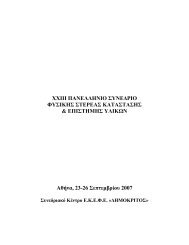Salicylaldoxime (H2salox) in iron(III) carboxylate chemistry ...
Salicylaldoxime (H2salox) in iron(III) carboxylate chemistry ...
Salicylaldoxime (H2salox) in iron(III) carboxylate chemistry ...
You also want an ePaper? Increase the reach of your titles
YUMPU automatically turns print PDFs into web optimized ePapers that Google loves.
712 C.P. Raptopoulou et al. / Polyhedron 24 (2005) 711–721and phenolate groups as chelat<strong>in</strong>g and/or bridg<strong>in</strong>g units,along with their ability to act <strong>in</strong> their mono- or di-anionicform, make them <strong>in</strong>terest<strong>in</strong>g candidates for theexploration of their metal coord<strong>in</strong>ation <strong>chemistry</strong> [9].In their mono-anionic form, phenolic oximes usuallyact as chelat<strong>in</strong>g agents through their oximatenitrogen and phenolate oxygen atoms (mode A <strong>in</strong>the follow<strong>in</strong>g scheme) <strong>in</strong> a variety of mono- andpoly-nuclear metal complexes [10–14]. A more <strong>in</strong>terest<strong>in</strong>gcoord<strong>in</strong>ation mode, <strong>in</strong>cludes the use of the phenolateoxygen atom as both chelat<strong>in</strong>g and bridg<strong>in</strong>g agent(mode B) [10,15].In their di-anionic form, phenolic oximes usually usetheir phenolate oxygen and oximate nitrogen atoms tochelate to one metal ion and their oximate oxygen asbridg<strong>in</strong>g unit to b<strong>in</strong>d a second metal (mode C). A varietyof di- [16–18], tri- [14,19] and tetranuclear [20–22] metalcomplexes present<strong>in</strong>g the l 2 :g 1 :g 1 :g 1 coord<strong>in</strong>ationmode have been reported. The oximate oxygen atomcan also b<strong>in</strong>d two metal ions, present<strong>in</strong>g thel 3 :g 1 :g 2 :g 1 coord<strong>in</strong>ation mode (mode D) giv<strong>in</strong>g rise tohigher nuclearity complexes, such as hexanuclear[23,24], although this coord<strong>in</strong>ation mode is also observed<strong>in</strong> tr<strong>in</strong>uclear [25] and tetranuclear [11] complexes.There is also one example [10] where the dianion of phenolicoximes can act as chelat<strong>in</strong>g tridentate ligandaccord<strong>in</strong>g to mode E.ACH=N-OHOOCMCH=N-OMMCH=N-OHOMBODMCH=N-OMMM<strong>iron</strong>(<strong>III</strong>) salicylaldoximato complex is the tetranuclear[11] cluster [{Fe(Hsalox)(salox)} 4 ], <strong>in</strong> which the fourHsalox act as chelat<strong>in</strong>g agents through their phenolateoxygen and oximate nitrogen atoms (mode A), whilstthe four salox 2 further use their oximate oxygen atomto b<strong>in</strong>d to two additional metal centers (mode D). In therema<strong>in</strong><strong>in</strong>g examples, coligands have been used to completethe coord<strong>in</strong>ation spheres of <strong>iron</strong>(<strong>III</strong>) centers <strong>in</strong>polynuclear complexes. In the d<strong>in</strong>uclear compound[(Me 3 tacn)Fe(<strong>III</strong>)(salox) 3 Fe(<strong>III</strong>)] [16], as well as <strong>in</strong> thetetranuclear compound [(Me 3 tacn) 2 Fe 4 (salox) 2 (l 3 -O) 2(l 2 -CH 3 CO 2 ) 3 ](ClO 4 ) [20] (where Me 3 tacn = 1,4,7-trimethyl-1,4,7-triazacyclononane)the dianion ofsalicylaldoxime adopts the l 2 :g 1 :g 1 :g 1 coord<strong>in</strong>ationmode. The only tr<strong>in</strong>uclear <strong>iron</strong>(<strong>III</strong>) salicylaldoximatocomplex known so far is [(C 2 H 5 ) 3 NH][Fe 3 O(Hsalox)(salox)2 (salmp)] [19] (salmp = 2-(bis(salicylideneam<strong>in</strong>o)-methyl)phenol, a new ligand formed dur<strong>in</strong>g thereaction process), where the Hsalox ligands act as chelat<strong>in</strong>gunits and the salox 2 ligands adopt thel 2 :g 1 :g 1 :g 1 coord<strong>in</strong>ation mode.The aim of our project is to explore the use of salicylaldoxime<strong>in</strong> <strong>iron</strong>(<strong>III</strong>) <strong>carboxylate</strong> <strong>chemistry</strong>, encouragedby our previous results on manganese(<strong>III</strong>) [24]. Here<strong>in</strong>,we report the first results of our project, <strong>in</strong> particularthe synthesis, X-ray crystal structure, spectroscopic (solidstate and frozen solutions EPR, Mössbauer) characterizationand magnetic behavior of two neutraltr<strong>in</strong>uclear oxo-centered <strong>iron</strong>(<strong>III</strong>) complexes, [Fe 3 (l 3 -O)-(O 2 CPh) 5 (salox)L 1 L 2 ](L 1 =L 2 = MeOH (1), L 1 = EtOH,L 2 =H 2 O(2)). The reported complexes are the first examplesof tr<strong>in</strong>uclear carboxylato <strong>iron</strong>(<strong>III</strong>) complexes withsalicylaldoxime, and can be considered as precursorsfor the synthesis of higher nuclearity complexes, basedon the pr<strong>in</strong>ciple of us<strong>in</strong>g Ômetal oximatesÕ as Ôbuild<strong>in</strong>gblocksÕ for polynuclear clusters. In both compounds,the salox 2 ligands adopt the l 2 :g 1 :g 1 :g 1 coord<strong>in</strong>ationmode (mode C) thus, the possibility of further us<strong>in</strong>gthe oximate oxygen atom, under certa<strong>in</strong> reaction conditions,to b<strong>in</strong>d to a second metal is left open.2. ExperimentalCH=NO2.1. Compound preparationsOEMAll manipulations were performed under aerobic conditionsus<strong>in</strong>g materials as received (Aldrich Co). Allchemicals and solvents were of reagent grade.Further restrict<strong>in</strong>g our discussion to polynuclear<strong>iron</strong>(<strong>III</strong>) complexes with the simplest member of thephenolic oximes, 2-hydroxy-benzaldehyde (salicylaldoxime,H 2 salox), only a few examples have beenreported. As far as we know, the only example of2.1.1. [Fe 3 (l 3 -O)(O 2 CPh) 5 (salox)(MeOH) 2 ] Æ1.25MeOH Æ 1.05H 2 O(1)A methanolic solution of H 2 salox (0.069 g,0.50 mmol) was stirred under reflux, until sodium benzoate(0.216 g, 1.50 mmol) was added. The refluxcont<strong>in</strong>ued for 30 m<strong>in</strong> and then Fe(NO 3 ) 3 Æ 9H 2 O
















